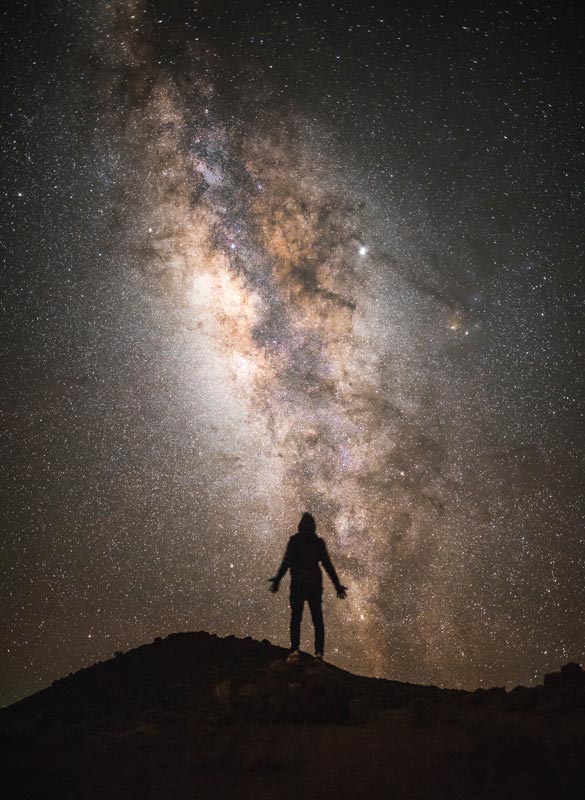About Us
About Us
Imua TMT supports having the Thirty Meter Telescope in Hawaii on the top of Mauna Kea. It is our resolved and unified belief that Mauna Kea is the perfect place for discoveries that will be exciting to more than just scientists but will also help improve the lives of Hawaiians and everyday people around the world.
TMT is about more than just stargazing. The science behind the telescope’s creation and the future discoveries it is sure to make will change the world. Make no mistake, astronomy is the reason you have both a cell phone as well as GPS. As we understand more about how stars support life on other planets, potentials to help save the earth become practical initiatives, not just theoretical ideas.
TMT on Mauna Kea will change the earth for the better. As Native Hawaiians, we believe that the “piko of the earth’ was entrusted to us here in Hawaii, not just because we have the reverence to protect it, but because we have the vision of our ancestors who followed the stars to get here, to create a better home for our people.
It’s time to take our people into the future.
Who is Imua TMT?
Imua TMT is a group of individuals across many generations and cultures who value Hawaii’s unique people, past, and position on planet earth to continue to understand where we are in our universe through ground astronomy.
Imua TMT is not affiliated with, nor does it speak for, the TMT Project.


Malia Martin, Founder
Malia Martin is a Native Hawaiian and a true ambassador of the islands. Adopted by mainland transplants, Malia embraced her deep cultural connection when she met her Samoan father and Hawaiian-Chinese mother. Malia holds a Philosophy degree from the Franciscan University of Steubenville and as a student, teacher, and administrator in Hawaii’s learned first-hand that many local children felt the limitations of Hawaii’s opportunities after graduation both academically and economically. Currently, she works for a global travel company helping the world understand the true spirit of aloha. Her advocacy for TMT is part of her bigger vision to encourage sustainable\non-tourism industries for future generations of Hawaii.
Sam Wilder King II, Executive Director
Sam Wilder King II has deep Native Hawaiian roots as a descendant of Kalanio’oulumokuikekai, who died at the Battle of Nu’uanu in 1795 and who’s daughter, Mahi was given in marriage to Olver Holmes who served as a governor under King Kamehameha. Since the unification of the Hawaiian Nation under King Kamehameha, Sam’s family has played an active role in advocating for a better Hawai’i for all. Among many Hawaiian issues that Sam has advocated for, TMT is currently at the forefront of his passion because he believes in its long-term benefits to all the people of Hawai’i, native and local-born, with millions of dollars of investment and jobs while simultaneously ensuring that Hawai’i, its people, and culture remain at the forefront of international science and discovery.
Mailani Neal, Director
Mailani Neal was born and raised in Kona on the Island of Hawai‘i. She attended Kamehameha Schools Kapālama for five years and finished high school at Hawai‘i Preparatory Academy. Mailani received her Bachelor of Science in Applied Physics with a concentration in astronomical instrumentation at Rensselaer Polytechnic Institute. She obtained her Masters of Science in physics with a concentration in instrumentation from New Mexico Tech. Mailani spent two summers as an intern in engineering technology at the East Asian Observatory—James Clerk Maxwell Telescope on Mauna Kea.
Tyler Trent, Director
A Native Hawaiian Kamehameha School graduate who is currently a PhD student in astrophysics. Tyler believes the incalculable benefits the TMT offers for Hawai‘i’s students is its financial support for STEM (Science-Technology-Engineering-Mathematics) education in Hawai‘i’s schools. Tyler is enthusiastic about his studies and the pursuit of scientific excellence on Mauna Kea, which comes in tandem with historical, cultural, and environmental sensitivity.
“…to say that Native Hawaiians have a singular view about the utilization of Mauna Kea, it’s wrong. We’re a diverse culture with many different ideas and beliefs, and their letter [protestors to SACNAS, the Society for the Advancement of Chicanos/Hispanics and Native Americans in Science, in 2019] specifically emboldens the argument that says that if you don’t believe this or that, then you’re not a real Native Hawaiian. And that was so hurtful because that’s the kind of thing I’ve gotten told multiple times: if you don’t believe that the Mauna Kea should be this way or that way, then you’re not a real Native Hawaiian, you have no cultural identity as a Native Hawaiian.” Tyler is a proud Native Hawaiian, and he supports the pursuit of astronomy on Mauna Kea.
What is the Argument Over TMT?
The opposition of TMT is not unified in thought or argument. Many people are jumping on an emotional bandwagon that includes prominent Hawaiian leaders being arrested for civil disobedience.
The issues against TMT range and vary among protesters in terms of importance:
Specific Mauna Kea Location
Environmental Impact
Economic Benefit
Native Hawaiian Issues
We at Imua TMT share all the same concerns as our fellow Hawaiians. But we haven’t stopped with snap media snippets based on fears. For years, we dug deep into the issues, spoke with experts in Hawaiian culture and history, science, and economics.
The Desecration of a Sacred Place
We wouldn’t be transparent if we didn’t discuss the claims that Mauna Kea is one of the most sacred places on earth according to Hawaiian culture and customs. This is why there are protesters blocking the road up the mountain preventing the legal passage of construction vehicles prepared to deliver the materials and tools needed to start building TMT.
Imua TMT acknowledges that the region of Mauna Kea is seen as the “piko of the earth,” a place where deep ancestral roots are tied and honored. From the research we can find, the piko’s importance in Hawaiian culture is “linking one generation to another, a physical link to all ancestors” in order to help “values and knowledge interface to cultivate a cultural consciousness.”
First, all research shows that the area of Mauna Kea reserved for ritual is more than 1 mile away from the actual TMT location. Second, consider the idea of “linking one generation to another,” as being the noblest of causes that a telescope of this magnitude will do.
If helping to link the past to the present to find a better future for our children is not honoring a sacred place, then nothing will ever honor it.
There are those who will say that Mauna Kea is the “realm of the gods.” In ancient times, the kapu system forbid most people from entering the area. The building of the first telescopes on Mauna Kea with its road has actually made it possible for cultural practitioners to access the sacred region.
This shows that the study of the stars and worship of the heavens have coexisted for decades peacefully.

